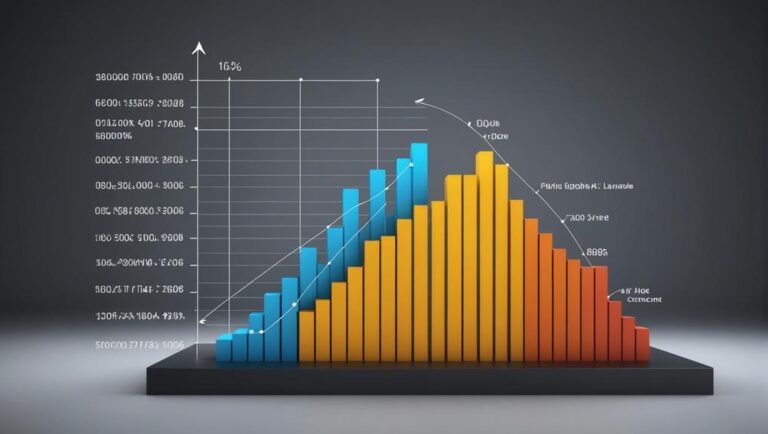Unlocking the Secrets of Free Cash Flow
Uncover the mysteries of free cash flow by analyzing its definition, components, and calculation methods. Understanding operating cash flow adjustments, changes in working capital, and capital expenditures are key components. Calculating FCF accurately involves various methods like starting with operating cash flow or EBIT and utilizing forecasting techniques. Interpreting FCF trends offers insights into financial health and growth prospects. Revealing the secrets of FCF aids in evaluating operational efficiency and making informed financial decisions. Explore the complexities of FCF to gain a deeper understanding of a company's financial landscape and potential opportunities.
Key Takeaways
- Understanding FCF components like operating cash flow adjustments is essential.
- Methods of calculating FCF vary, including starting with operating cash flow or EBIT.
- Analyzing FCF trends aids in forecasting future cash flows and assessing financial performance.
- FCF analysis is crucial for evaluating financial health, operational efficiency, and growth opportunities.
- Factors influencing FCF include inventory management, working capital fluctuations, and credit issues.
FCF Definition and Components
Defining Free Cash Flow (FCF) and its components is fundamental in comprehending a company's financial health and operational efficiency. The breakdown of FCF components includes operating cash flow adjustments for non-cash expenses, changes in working capital, and capital expenditures.
Uncovering FCF complexities involves understanding how FCF excludes interest payments and focuses on cash available for essential financial obligations like dividends and debt repayments. Analysts often dissect FCF into variations like FCF for the firm and FCF to equity to gain deeper insights into a company's financial performance.
Methods of Calculating FCF
To further explore the intricacies of Free Cash Flow (FCF) analysis, understanding the Methods of Calculating FCF is pivotal for evaluating a company's financial performance accurately. Comparative analysis of different methods, such as starting with operating cash flow or EBIT, allows for a more thorough view.
Forecasting techniques play an essential role in projecting future FCF, considering adjustments like interest, taxes, CapEx, and working capital changes. The preferred calculation method depends on the availability and reliability of financial data. Accuracy in FCF calculation is paramount for effective financial analysis.
Trend analysis simplifies performance evaluation, emphasizing trend stability over absolute FCF values. Positive FCF trends commonly align with stock price trends, while divergence from earnings trends may indicate underlying issues that require attention.
Interpreting FCF Trends
Analyzing fluctuations in Free Cash Flow (FCF) trends provides valuable insights into a company's financial performance and operational efficiency. When interpreting FCF trends, consider the following:
- Cash Flow Dynamics: Understanding how FCF changes over time helps in evaluating the company's ability to generate cash and meet financial obligations.
- Forecasting: Utilizing historical FCF trends aids in forecasting future cash flows, enabling better financial planning and decision-making.
- Investment Strategies: FCF trends impact investment decisions, as positive trends may indicate opportunities for growth and expansion.
- Risk Assessment: Divergence in FCF trends can signal underlying risks, prompting a deeper analysis to mitigate potential financial challenges.
Importance of FCF Analysis
Understanding the significance of Free Cash Flow (FCF) analysis is pivotal in evaluating a company's financial health and operational efficiency. FCF impact on a company's cash generation is vital as it represents the cash available for various stakeholders, including creditors, shareholders, and reinvestment in the business.
Analyzing FCF provides insights into the company's ability to meet financial obligations, invest in growth opportunities, and sustain operations. By examining FCF trends and levels, investors and analysts can assess the company's capacity for dividend payments, debt repayment, and future growth.
Effective FCF analysis aids in making informed investment decisions, identifying potential risks, and understanding the overall financial performance and stability of a company.
Factors Influencing FCF
Factors affecting Free Cash Flow (FCF) can stem from various operational, financial, and external influences within a company's environment. These factors play an essential role in shaping the cash flow dynamics of a business. Here are four key influences on FCF:
- Inventory Management: Inefficient inventory practices can tie up cash, affecting FCF negatively.
- Working Capital: Fluctuations in working capital levels impact the cash available for operations and investments.
- Credit Issues: Issues with credit management can lead to cash flow constraints, affecting FCF.
- Payment Terms: Supplier or client payment terms can either alleviate or strain FCF, depending on the agreements in place.
These factors highlight the importance of managing operational aspects effectively to optimize Free Cash Flow.
FCF in Financial Decision Making
Utilizing Free Cash Flow (FCF) as a guiding metric in financial decision-making provides a robust framework for evaluating a company's operational efficiency and investment potential. FCF impacts cash allocation decisions greatly, influencing choices related to dividends, debt repayment, share buybacks, and capital expenditures. By analyzing FCF trends and values, management can make informed decisions on how to best utilize available cash resources. The table below illustrates the key aspects of FCF's impact on financial decision-making:
| FCF Impact | Examples of Cash Allocation |
|---|---|
| Supports Growth | Investing in new projects and ventures |
| Debt Reduction | Paying off loans and reducing interest expenses |
| Shareholder Returns | Issuing dividends or executing share repurchases |
Understanding FCF for Evaluation
When evaluating a company's financial performance, the analysis of Free Cash Flow (FCF) serves as an essential metric for gauging operational efficiency and investment potential. Understanding FCF for evaluation involves delving into cash management and investment strategies. Here are four key points to keep in mind:
- Cash Management: FCF allows insight into how efficiently a company manages its cash flow, highlighting its ability to meet financial obligations and fund future growth.
- Investment Strategies: FCF analysis aids in evaluating the effectiveness of a company's investment decisions, indicating whether it can sustain operational activities and pursue growth opportunities.
- Operational Efficiency: FCF helps assess how well a company converts its revenue into cash, reflecting its operational effectiveness.
- Financial Health: FCF provides crucial information on a company's financial health, guiding stakeholders in making informed decisions regarding investments and financial stability.
Conclusion
To sum up, Free Cash Flow (FCF) serves as a critical indicator of a company's financial health and operational efficiency. Like a compass guiding a ship through turbulent waters, FCF provides valuable insights into a firm's ability to generate cash, sustain dividends, and support growth initiatives.
By understanding the nuances of FCF analysis and its implications for investment decisions, stakeholders can navigate the complex landscape of corporate finance with confidence and clarity.






